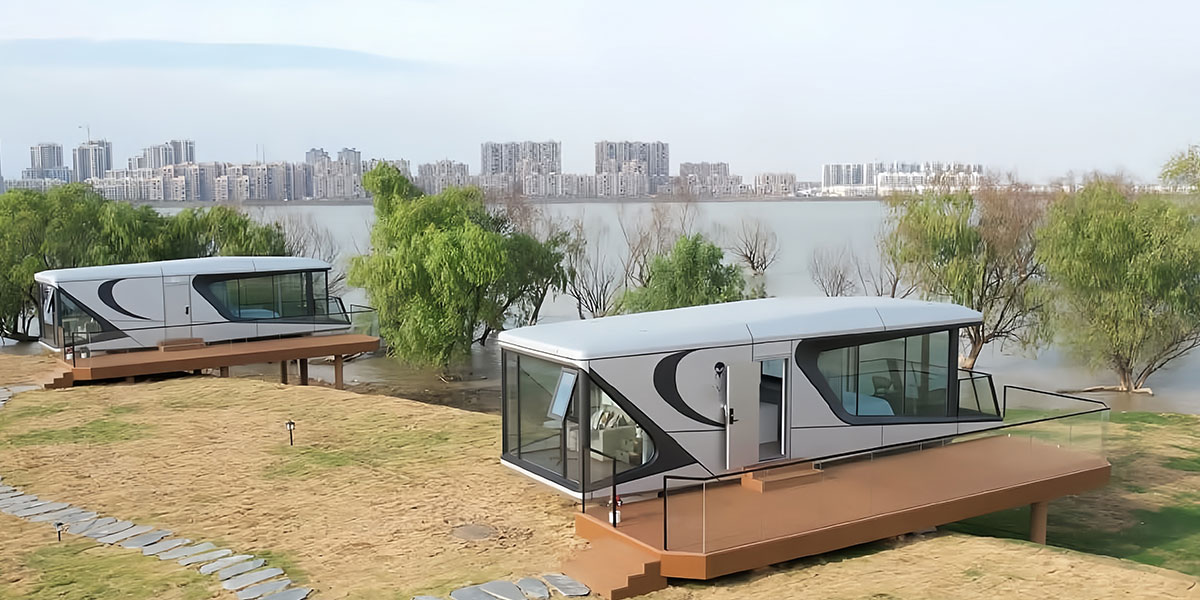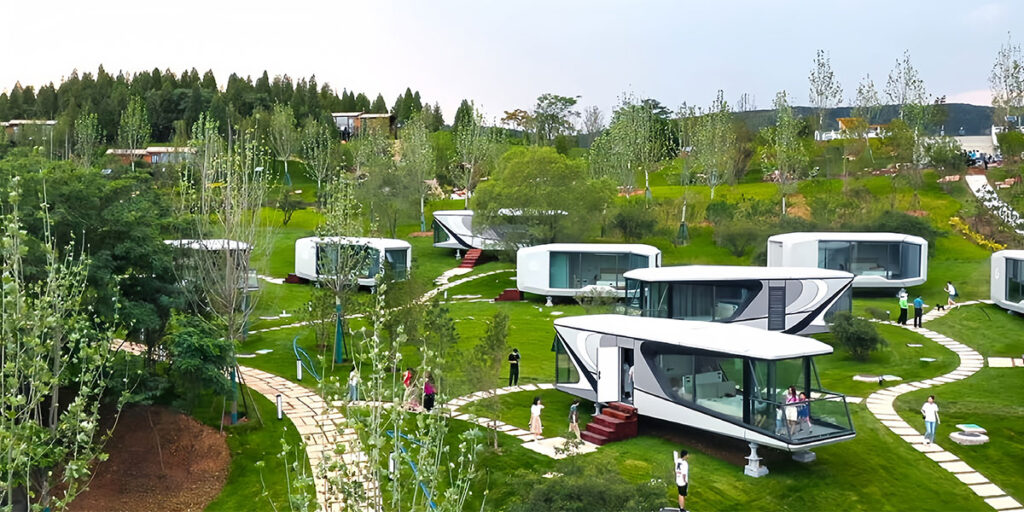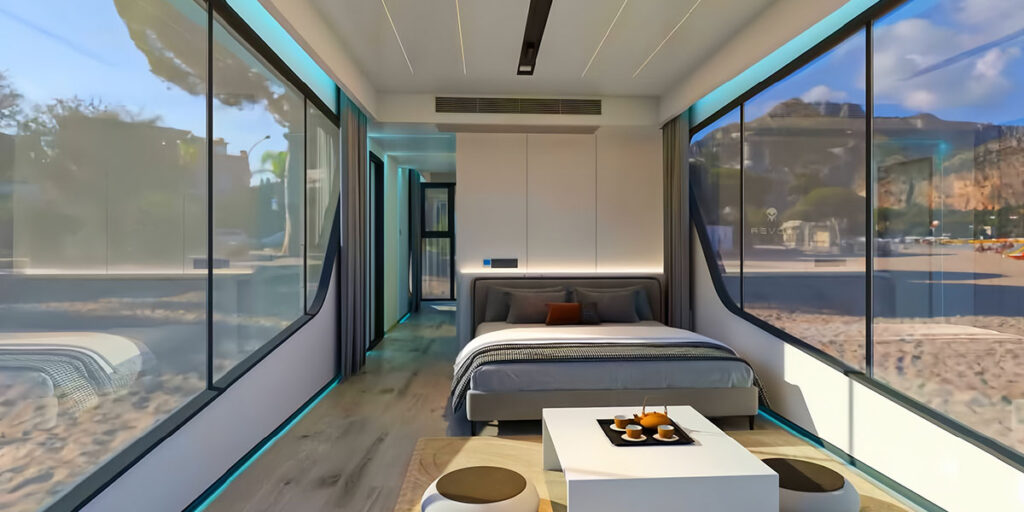
05 Jul What Are Capsule Tiny Houses and How They Redefine Compact Living
Table of Contents
Imagine a home with everything you need in one small space. That’s what capsule tiny houses are all about. They are small, box-like homes made to save space and stay cozy. These houses are great for people in cities or those who like simple living.
Capsule houses are changing how we see small homes. Their smart designs make tiny spaces useful and welcoming. As cities grow bigger—more than half the world lives in them—these homes solve housing problems. They also use green materials, making them good for the planet and modern life.
Key Takeaways
Capsule tiny houses use smart designs to save space. They make small areas feel bigger and cozy.
These homes can be moved easily, so you can live anywhere. They are great for travelers and remote workers.
Capsule homes use green materials and save energy. This helps the planet and cuts down on bills.
Cool tech makes life easier in capsule houses. It adds modern features and saves time and energy.
Capsule tiny houses are cheap and stylish. They support simple living and help the environment.
Features of a Capsule Tiny House
Space-efficient and multifunctional design
Capsule tiny houses use space in very smart ways. Every part of the home has a purpose. Furniture often has two uses, like beds that fold into walls or tables that turn into desks. This makes the small space feel much bigger.
Picture a kitchen where a counter hides a pull-out table. Or imagine a living room that becomes a bedroom at night. These creative designs give you the comfort of a regular home without needing much space. Capsule homes are great for people who love practical and clever designs.
Tip: If you have trouble with clutter, capsule homes can help you stay neat and live simply.
Mobility and portability for flexible living
Capsule tiny houses are easy to move and very flexible. Many are portable, so you can take them wherever you want. Whether it’s near the beach, in the mountains, or close to the city, these homes make it possible.
Some capsule homes can be pulled like trailers. Others can be moved on flatbed trucks. This means you don’t have to stay in one place. You can change your location based on your needs, whether for work, fun, or a new start.
Did you know? Capsule homes are loved by travelers and digital nomads who enjoy freedom and flexibility.
Eco-friendly materials and energy efficiency
Capsule tiny houses are built to be kind to the planet. Many use materials like reclaimed wood, recycled metal, or bamboo. These choices reduce waste and make the homes look stylish and unique.
They are also energy-efficient. Many come with solar panels, energy-saving appliances, and good insulation to lower utility bills. Some even have rainwater systems and composting toilets, perfect for off-grid living.
Choosing a capsule house helps the environment while saving space. These homes show that small living can make a big difference for the planet.
Fun Fact: Capsule homes are designed to leave a tiny carbon footprint, making them ideal for eco-friendly living.
Smart technology for modern convenience
Living in a capsule tiny house doesn’t mean losing modern comforts. In fact, smart tech makes these homes feel advanced and super easy to live in. Even in a small space, technology can do a lot to help.
What kind of smart tech can you expect?
Capsule homes often include high-tech gadgets to save time and energy. Here are some examples:
Smart thermostats: Keep your home cozy and save energy at the same time.
Voice-activated assistants: Use your voice to control lights, music, or appliances.
Automated lighting systems: Lights adjust to the time of day or your needs.
Security cameras and smart locks: Protect your home, even when you’re not there.
Energy monitoring systems: Track energy use and find ways to save money.
Tip: If you’re new to smart tech, start with a voice assistant. It’s simple to use and works with other devices as you grow your setup.
How does smart tech fit into small spaces?
In a capsule tiny house, every bit of space is important. Smart tech helps you use it wisely. For example:
Foldable smart furniture: A bed that folds into the wall and works as a desk, all controlled by an app.
Compact appliances: Small smart fridges or washers fit tiny homes but work just as well.
Integrated systems: One app can control many things, so you don’t need extra gadgets.
Why is smart tech a game-changer?
Smart tech doesn’t just make life easier; it saves time and money too. Automated systems adjust the thermostat or turn off lights when you leave. This cuts energy waste and lowers bills. Plus, you can control everything from your phone, even when you’re away.
Fun Fact: Some capsule homes have AI systems that learn your habits. They adjust settings automatically, like having a personal helper!
Is it worth the investment?
Yes! Smart devices may cost more at first, but they save money over time. You’ll spend less on utilities, enjoy more convenience, and even boost your home’s value. These features make your tiny home feel modern and fancy, no matter its size.
So, if you’re thinking about a capsule tiny house, don’t forget about smart tech. It’s a great way to mix innovation with small-space living. 🌟
Benefits of Capsule Tiny Houses

Affordable and cost-effective housing solution
Capsule tiny houses are a great choice for saving money. They cost much less to build and take care of than regular homes. You won’t need to worry about big loans or high rent. Instead, you can own a small, cozy home without spending too much.
These homes are cheaper because they are smaller and use fewer materials. Builders often pick eco-friendly and reused materials, which cost less and help the planet. Plus, energy-saving designs mean lower utility bills, so you save even more over time.
Tip: If you’re on a budget, capsule homes let you own a stylish and comfy home without overspending.
Promotes sustainability and reduces carbon footprint
Capsule tiny houses are great for the environment. They are built to take up less space and use eco-friendly materials like recycled wood or metal. This helps reduce waste and supports green living.
Studies show that tiny homes made with natural materials, like wood, have less impact on the environment than regular houses. For example, using old wind turbine parts to build a tiny house can lower its environmental harm. This shows how capsule homes can help the planet.
Many capsule homes also include solar panels, rainwater systems, and composting toilets. These features let you live off-grid while staying eco-friendly. Choosing a capsule home means saving space and helping the Earth.
Fun Fact: Living in a capsule home can cut your energy use by half, saving money and helping the planet!
Encourages minimalist and intentional living
Living in a capsule tiny house helps you live simply. With less space, you’ll focus on what’s really important. You’ll keep only the things you need or love, making life less cluttered.
This way of living can feel freeing. You’ll spend less time cleaning and more time enjoying life. Capsule homes help you avoid the mess and stress of bigger homes.
Did you know? Living simply can lower stress and clear your mind. A capsule home could be the fresh start you need!
By choosing a capsule tiny house, you simplify your life and help the planet. It’s a smart way to live that matches today’s values of saving money, being eco-friendly, and living with purpose.
Works Well in Different Places and for Many Lifestyles
Capsule tiny houses are like shape-shifters—they fit almost anywhere. Whether you’re in a busy city, a peaceful countryside, or far from others, these homes work perfectly.
How do capsule homes handle different places?
Capsule tiny houses are made to suit all kinds of areas. For example:
Cities: Their small size makes them great for tight spots like rooftops or small lots.
Countryside: They look natural in green spaces, giving you a cozy escape.
Tough weather: Some are built strong to handle snow, wind, or storms.
Some capsule homes are even ready for off-grid living. They come with solar panels, rainwater systems, and composting toilets, making them great for remote areas.
Tip: Want to live off the grid? Pick a capsule home with eco-friendly features.
How do they match different lifestyles?
Capsule tiny houses aren’t just about where you live—they’re about how you live. These homes fit many ways of life:
Simple living: If you like less stuff, these homes help you stay focused.
Travelers: You can move your home to new places easily.
Families: Modular designs let you change layouts as your family grows.
Eco-friendly people: Green materials and energy-saving systems match your values.
Capsule homes can also be adjusted for special needs. For example, you can add ramps or wider doors for better access. Their flexibility makes them a great choice for anyone wanting a custom home.
Why does flexibility matter?
Flexibility helps make a house feel like home. Capsule tiny houses let you live where and how you want. They’re more than homes—they’re smart solutions for today’s lifestyles.
Fun Fact: Some capsule homes can float on water, making them perfect for living by lakes or rivers!
Capsule tiny houses show that you don’t need a big space to live fully. Their flexibility lets you try new things, visit new places, and create a home that’s just right for you.
Challenges of Living in a Capsule Tiny House
Space constraints and storage limitations
Living in a capsule tiny house means using space wisely. These homes are small, so you’ll need to plan carefully. Storing all your belongings can be hard, especially if you’re used to bigger spaces. Closets are tiny, and there’s no room for large furniture or extra stuff.
Smart storage ideas can help make it work. Use furniture that stores items, like beds with drawers or shelves built into walls. You’ll also need to get rid of things you don’t need. Living with fewer items can feel freeing and less stressful.
Tip: Sort your things into groups and donate or sell extras. It’s a great way to keep life simple!
Finding a spot for your capsule tiny house can be tricky. Zoning rules often limit how small homes can be. Some places require houses to be a certain size, which tiny homes don’t meet. Cities usually have stricter rules than rural areas, making urban spots harder to find.
RV parks might seem like an option, but many don’t allow tiny homes unless they follow RV rules. Even when people challenge zoning laws, wins are rare. Here’s a quick look at common legal issues:
Problem | Example |
|---|---|
Minimum home size | Tiny homes may not meet size rules |
RV park limits | Tiny homes must follow RV standards |
City zoning rules | Fewer choices in cities than rural areas |
Note: Check local zoning rules before picking a location. It’ll save you time and trouble.
Adjusting to a minimalist lifestyle
Living in a capsule tiny house means changing how you live. You’ll need to keep only what’s important and let go of extra stuff. This can feel hard at first, especially if you’re used to having more space.
You might miss big kitchens or rooms for hobbies. But over time, you’ll enjoy the simplicity. Living with less can lower stress and help you focus on experiences instead of things.
Did you know? Living simply can improve mental health by reducing clutter and stress.
It takes time to adjust, but it’s worth it. You’ll see that less can truly be more.
Possible sacrifices in comfort and features
Living in a capsule tiny house means choosing a simpler way of life. However, it also means giving up some comforts found in regular homes.
Smaller kitchen and bathroom areas
The kitchen and bathroom in a capsule home are very small. Instead of a big kitchen, you might have a tiny kitchenette. Cooking big meals can be tricky with little counter space and small appliances.
Bathrooms are basic, often just a shower, toilet, and sink. Some homes even use composting toilets or shared bathrooms, which may take time to adjust to.
Tip: If you love cooking or need more bathroom space, pick a capsule home with options to expand.
Limited entertainment space
Capsule homes don’t have room for big TVs or gaming setups. Hosting movie nights or parties might not be possible. Instead, you can enjoy smaller gatherings or outdoor fun.
Less privacy
The open design of capsule homes makes privacy harder to find. Curtains or sliding panels often replace walls and doors to save space. This works well for one person but might feel tight for couples or families.
Did you know? Some capsule homes use soundproof panels to create private spaces without taking up extra room.
Compact furniture adjustments
Regular furniture won’t fit in most capsule homes. You’ll need smaller or multi-use pieces, like foldable chairs or wall desks. These are smart designs but may not feel as comfy as regular furniture.
Living in a capsule tiny house means trading some comforts for a simpler, smarter lifestyle. It’s about finding what fits your needs and values. 🌟
Costs of Capsule Tiny Houses
Overview of purchase and financing options
Capsule tiny houses cost much less than regular homes. Prices range from $30,000 to $120,000, depending on size and features. In comparison, a traditional home costs about $300,000. This makes capsule homes a great choice for people on a budget.
Type of House | Average Price Range |
|---|---|
Capsule Tiny Houses | $30,000 – $120,000 |
Traditional Homes | $300,000 |
Financing a capsule home is also easier. Since they’re cheaper, you might not need a big loan. Some people use personal loans or save money to pay upfront. This makes owning a capsule home more possible for many buyers.
Tip: Ask local banks about loans for small homes. You might find a plan that works for you.
Maintenance and operational expenses
Capsule tiny houses are simple to take care of. Their small size means fewer repairs and lower costs. You won’t need to fix big roofs or mow large lawns. Cleaning is quick, and you’ll spend less on supplies.
Running costs are also low. Heating and cooling a small space is cheaper than in a regular house. Many capsule homes use strong materials like bamboo or metal, which last longer and need fewer fixes.
Did you know? Some capsule homes come with warranties for major parts. This can save you money on unexpected repairs.
Utility costs and energy savings
Utility bills for capsule tiny houses are very low. Their small size means you use less electricity, water, and gas. Many come with energy-saving features like solar panels, LED lighting, and insulated walls. These features help you save money and protect the environment.
Here’s how capsule homes lower utility costs:
Solar panels: Make your own electricity and cut monthly bills.
Energy-efficient appliances: Use less power but still work well.
Rainwater systems: Collect rainwater to save on water bills.
Fun Fact: Some capsule homes are so efficient that utility bills drop by 50%!
Capsule tiny houses are affordable to buy and cheap to maintain. They mix smart design with cost-saving features, making them a great choice for modern living.
Cost comparison with traditional housing
Buying a home can be very expensive. Regular houses often cost hundreds of thousands of dollars. You also have to pay for upkeep, utilities, and property taxes. Capsule tiny houses are much cheaper and easier to afford.
How do the costs compare?
Here’s a simple chart to show the difference:
Expense Type | Capsule Tiny House | Traditional Home |
|---|---|---|
Purchase Price | $30,000 – $120,000 | $300,000+ |
Monthly Utilities | $50 – $150 | $200 – $500 |
Maintenance Costs | Low | High |
Property Taxes | Minimal or None | Significant |
Capsule homes cost much less than regular houses. You save money when you buy one and on monthly bills too.
Why are capsule homes less expensive?
Capsule homes are small, so they need fewer materials to build. Builders often use recycled or eco-friendly materials, which are cheaper. Their small size also means lower heating and cooling costs. You won’t have to spend much on repairs or yard work either.
Tip: Want to save money? Capsule homes are a great choice. They’re affordable and still look nice.
What about saving money over time?
Capsule homes are made to help you save in the long run. Solar panels and LED lights lower energy bills. Repairs are simple, so you won’t face big costs. Many capsule homes don’t have high property taxes either.
Regular houses may give you more space, but they cost more. Capsule tiny houses show you can live well without spending a lot. They’re a smart option for today’s world.
Fun Fact: Some capsule homeowners save enough money to travel or try new hobbies. What would you do with extra savings?
Innovations in Capsule Tiny Houses

Modular and customizable layouts
Capsule houses are super flexible thanks to modular designs. You can change or expand your home easily. These homes have sections you can add, remove, or rearrange. This makes it simple to adjust your space as your needs change.
Start with one module for a small living area. Later, add another for a workspace or guest room. This way, your home grows with you. It’s like having a house that changes to match your lifestyle.
Tip: Choose a capsule house with modular features. It helps you stay flexible without needing more space.
Integration of smart home technology
Capsule houses may be small, but they use smart tech to make life easier. You can control lights, temperature, and security with your phone or voice.
Imagine coming home tired. Say a command, and your lights turn on, the heat adjusts, and music plays. These features save time and energy while making life more comfortable.
Some capsule homes even have energy trackers. These show how much power you use and suggest ways to save. Smart tech makes living simple and eco-friendly.
Fun Fact: Many capsule homes come with smart tech already installed, so you don’t have to set it up!
Off-grid living capabilities
Capsule houses are great for off-grid living. They use eco-friendly systems like solar panels for power, rainwater collectors for water, and composting toilets for waste.
This setup saves money and helps the planet. You’ll spend less on bills and lower your carbon footprint. Plus, you can place your home in quiet, remote areas.
Did you know? Some capsule homes are so efficient they work completely off the grid without losing comfort.
Capsule houses mix smart tech, modular layouts, and off-grid features. They’re perfect for modern living and eco-friendly lifestyles.
Futuristic and stylish design features
Capsule tiny houses are not only small but also super cool. Their modern designs make them unique and useful. If you enjoy sleek looks or creative styles, these homes will amaze you.
Smooth and modern outside looks
Capsule homes often have simple, clean exteriors. They feature straight lines, bold shapes, and materials like glass, wood, or metal. Some even look like something from a sci-fi movie! These designs are not just pretty—they’re made to last and handle tough weather.
Tip: Pick a capsule home that fits your style. Whether you like shiny metal or cozy wood, there’s a design for you.
Cool lighting ideas
Lighting makes these homes feel futuristic. Many use LED lights or smart systems for fun effects. Imagine soft lights under furniture or colorful glows on walls. These details make the space feel both modern and comfy.
Creative inside layouts
The interiors of capsule homes are just as amazing. You’ll see curved walls, hidden storage, and furniture that can change its use. Some even have glass ceilings or walls to let in sunlight and make the space feel bigger.
Fun Fact: Mirrors are used in some capsule homes to make rooms look larger. It’s a smart way to make small spaces feel open.
Why design matters
A good-looking home isn’t just about appearance—it’s about how it feels to live in. Capsule tiny houses mix beauty with usefulness, giving you a space that’s both functional and inspiring.
🌟 Imagine this: A small home that feels like a masterpiece. Wouldn’t that make living there more exciting?
Capsule tiny houses are changing how we view living spaces. They mix clever designs, low costs, and eco-friendly features to meet today’s needs. These homes aren’t just small—they solve big issues like housing shortages and environmental harm.
The advantages go beyond saving room. Capsule homes use 45% less energy and are 65% more efficient than regular houses. Prefab building methods also cut waste by 60%. These features make them a smart choice for anyone wanting to live green.
Whether you’re a student, young worker, or someone who loves simple living, capsule homes offer comfort and flexibility. They’re budget-friendly, eco-smart, and work well in many places. Choosing a capsule tiny house means saving money, helping the Earth, and living smarter.
Did you know? Capsule tiny houses are leading the way to a greener world, showing that small steps can create big changes.
FAQ
What is the average size of a capsule tiny house?
Capsule tiny houses are usually 100 to 400 square feet. They use smart designs to make every inch useful. Clever layouts and furniture make them feel bigger than they are.
Can capsule tiny houses handle extreme weather?
Yes, many capsule homes are made with strong materials and good insulation. Some even have reinforced walls or solar-powered heating for tough weather. They work well in snowy winters or hot summers.
Tip: Check the details to make sure your home fits your weather.
Do capsule tiny houses have bathrooms?
Yes! Most capsule homes have small bathrooms with a shower, toilet, and sink. Some also include eco-friendly options like composting toilets or water-saving features for off-grid living.
Can I customize my capsule tiny house?
Yes, many capsule homes have modular designs so you can change layouts or add features. You can pick eco-friendly upgrades or design a look that matches your style.
Fun Fact: Some capsule homes are so flexible, they can float on water!
Are capsule tiny houses legal everywhere?
Not always. Rules about tiny homes depend on where you live. Some places have size limits or rules for mobile homes. Check local laws before buying or setting up your capsule home.
Note: Rural areas often have fewer rules than cities.



